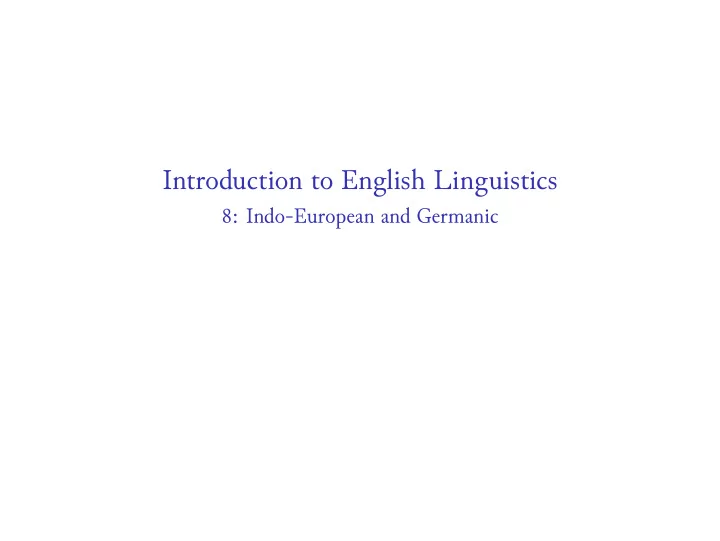

Introduction to English Linguistics 8: Indo-European and Germanic
Cognates Sanskrit Latin Gothic German English pitar- pater fadar Vater father * pellis fill Fell fell grha hortus gards Garten garden dvau duo twai zwei two dasa decem taihun zehn ten
Postulating an Ancestral Language *Proto-Indo-European English… and many more! Latin German Sanskrit Gothic (radical simplification; cf. next slide)
The Indo-European Language Family (Full View) Figure: Indo-European Family Tree (CC-BY-SA multiple WMC users)
The Indo-European Language Family (1/3) Figure: Indo-European Family Tree (detail; CC-BY-SA multiple WMC users)
The Indo-European Language Family (2/3) Figure: Indo-European Family Tree (detail; CC-BY-SA multiple WMC users)
The Indo-European Language Family (3/3) Figure: Indo-European Family Tree (detail; CC-BY-SA multiple WMC users)
The Indo-European Territory Today Figure: The Branches of Indo-European (CC-BY-SA WMC user)
The Dissemination of Indo-European Figure: Indo-European Expansion (CC-BY-SA WMC user)
“The Proto-Indo-Europeans”? We should take care not to conflate ▶ Language and (other aspects of ) culture; ▶ Ethnicity; ▶ Territory. These may overlap for a time, and strengthen each other when they do, but they are always fsee to go their separate ways.
The Centum/Satem Isogloss Sanskrit śatám Avestan satəm Lithuanian šim ̃ tas Old Church Slavonic sŭto Latin centum Greek hekatón Old Irish cēt Middle Welsh cant English hundred Tocharian känt Table: The realization of dorsal consonants in some Indo-European languages
The Centum/Satem Isogloss Figure: Centum/Satem-Distribution Today (CC-BY-SA WMC user)
Word Stress (Proto-)Indo-European Free word stress : the stressed syllable depends on a word’s inflection. (Proto-)Germanic Root stress : it is always the root syllable that is stressed, regardless of inflection.
Regularity Sanskrit Latin Gothic German English pitar- pater fadar Vater father * pellis fill Fell fell grha hortus gards Garten garden dvau duo twai zwei two dasa decem taihun zehn ten
Grimm’s Law aspirated voiced stops voiceless voiceless → → → voiced stops stops fricatives bʰ b p f → → → dʰ d t θ → → → gʰ g k x → → → edere etan → ager æcer → piscis fisc → fsater brōþor → pater fæder →
Verner’s Law aspirated voiced voiceless voiceless → → → voiced stops stops fricatives stops bʰ b p b → → → dʰ d t d → → → gʰ g k g → → → s r → if immediately preceded by IE word stress: p f → t θ → k x → s s → fsater brōþor → pater fæder →
Some Aspects of Proto-Indo-European Phonology ▶ /b/ extremely rare ▶ /p/ fsequent ▶ /s/ the only certain fsicative
Grammatical Alternation Verner’s Law explains alternation between e.g. ▶ h and g ▶ German ziehen , zog ▶ s and r ▶ MnE I was , we were ▶ OE fsēosan : ic fsēas , wē fsuron (cf. English fseeze , German fsieren ) ▶ OE cēosan : ic cēas , wē curon (cf. English choose , German küren ) ▶ ð and d ▶ OE snīðan : ic snāð, wē snidon (cf. German schneiden , schnitt ) ▶ f and b ▶ OE hebban , hōf (cf. German heben , MnE heave )
Germanic Developments: Distinction Strong/Weak Verbs Strong Tense formation characterized by gradation of the stem vowel: ▶ Ich sehe ihn / I see him / ég sé hann ▶ Ich sah ihn / I saw him / ég sá hann ▶ Ich habe ihn gesehen / I have seen him / (ég hef séð hann) Weak Tense formation characterized by a dental suffix: ▶ Ich höre ihn / I hear him / ég heyri hann ▶ Ich hörte ihn / I heard him / ég heyrði hann ▶ Ich habe ihn gehört / I have heard him / ég hef heyrt hann
Germanic Developments: Strong/Weak Adjectives Strong Gutes Bier First word in a phrase Gute Könige First word in a phrase Weak Das gute Bier Preceded by definite article Die guten Könige Preceded by definite article
Origins Figure: The spread of Germanic 750 c. bce–c. ce 200 (CC-BY-SA multiple WMC users)
The Germanic Language Family Figure: Germanic Family Tree (CC-BY-SA multiple WMC users)
Early Germanic Figure: Germanic prior to c. ce 300 (CC-BY-SA WMC user)
Gothic Figure: Codex Argenteus (public domain / WMC)
Spread of East Germanic Figure: Southern Europe c. ce 476 (CC-BY-SA WMC user)
North Germanic Postposed Article ▶ et universitet “a university” ▶ universitetet “the university” Middle Voice (Reflexive/Reciprocal/Passive Uses) ▶ berjask ; cf. German sich streiten ▶ Jag kallas Erik “I am called Erik” ▶ Vi ses “See you”
Germanic Dialects c. 1 ce (Traditional View) Figure: Germanic Dialects c. 1 ce (CC-BY-SA multiple WMC users)
The limes germanicus Figure: Lower limes germanicus to c. 200 ce (CC-BY-SA WMC user)
The Franks Figure: Carolingian Empire c. 814 ce (CC-BY-SA WMC user)
West Germanic Figure: West Germanic c. 500 ce (CC-BY-SA WMC user)
High German Consonant Shifu /p/ afuer vowels /ff/ <ff> → /t/ afuer vowels /ss/ <zz> → /k/ afuer vowels /xx/ <hh/ch> → /p/ initially, afuer /lmnr/, or geminated /pf/ <pf> → /t/ initially, afuer /lmnr/, or geminated /ts/ <z> → /k/ initially, afuer /lmnr/, or geminated /kx/ <ch/kh> → /d/ in some cases /t/ → /b/ mostly in geminates /p/ → /g/ mostly in geminates /k/ →
High German Consonant Shifu PG OS OE PDE OHG German pō- apo apa ape affe Affe *etan etan etan eat essen essen *makōn makōn macian make mahhōn machen *apala- appul æppel apple apful Apfel *twai twā twā two zwei zwei *daga- dag dæg day tacg Tag *rebja- ribbi ribb rib rippi/ribbi Rippe
Language Families? The Tree Model Parent Language Sibling 1 Sibling 2 Sibling 3 Daughter 1 Daughter 2
Language Families? The Tree Model Proto-Germanic West Germanic North Germanic East Germanic etc. Norwegian Swedish etc. Icelandic Faroese Danish
Dialect Continua? The Wave Model Figure: Each circle is a feature or group of features, more pervasive at the centre than in the periphery; the background represents a dialect continuum.
P . S. Langeslag
Recommend
More recommend